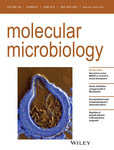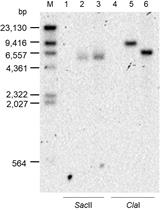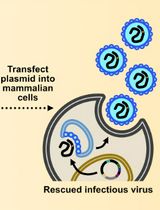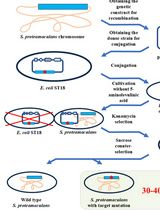- EN - English
- CN - 中文
Measuring Homologous Recombination Rates between Chromosomal Locations in Salmonella
沙门氏菌中染色体位点间的同源重组率测定
发布: 2019年02月05日第9卷第3期 DOI: 10.21769/BioProtoc.3159 浏览次数: 7459
评审: Valentine V TrotterSneha JaniAnonymous reviewer(s)
Abstract
Homologous recombination between two similar DNA molecules, plays an important role in the repair of double-stranded DNA breaks. Recombination can occur between two sister chromosomes, or between two locations of similar sequence identity within the same chromosome. The assay described here is designed to measure the rate of homologous recombination between two locations with sequence similarity within the same bacterial chromosome. For this purpose, a selectable/counter-selectable genetic cassette is inserted into one of the locations and homologous recombination repair rates are measured as a function of recombinational removal of the inserted cassette. This recombinational repair process is called gene conversion, non-reciprocal recombination. We used this method to measure the recombination rates between genes within gene families and to study the stability of mobile genetic elements inserted into members of gene families.
Keywords: Homologous recombination (同源重组)Background
Homologous recombination can occur between two strands of DNA that share a sufficient amount of sequence identity. Homologous recombination can result in either reciprocal exchanges (for example, during meiosis in diploid eukaryotes, when genetic information is exchanged between two homologous parental chromosomes to create novel gametic chromosomes), or non-reciprocal exchanges (such as during mating-type switching in Saccharomyces cerevisiae, when genetic information is copied from one location on a chromosome to another homologous location on the same chromosome, resulting in gene conversion). In reciprocal recombination no genetic information is lost, it is simply exchanged between two homologous chromosomes. In contrast, in a non-reciprocal recombination event, genetic information from one location is copied into another homologous location, and replaces the original information, resulting in gene conversion. In haploid bacteria there is no meiosis, but homologous recombination can take place between the bacterial chromosome and a foreign fragment of DNA, leading to a horizontal gene transfer event (Thomas and Nielsen, 2005) or between two homologous locations within the same chromosome, which can lead to gene conversion (Anderson and Roth, 1977; Abdulkarim and Hughes, 1996; Hughes, 2000).
To measure homologous recombination rates within bacterial chromosomes requires the ability to select for successful recombinant cells. Traditionally, this was achieved by the use of selectable markers. These were inserted in a mutated, inactive state into two locations of the chromosome and could recombine to form an active, selectable gene (Segall and Roth, 1989). The drawback of this method is that recombination occurs between the two inserted sequences and does not provide any information about the homologous recombination rates between native sites within the chromosome. We have developed a method that overcomes this drawback by the use of a counter-selectable marker (Brandis et al., 2018). A selectable/counter-selectable cat-sacB-yfp cassette (cat: selectable for chloramphenicol resistance, sacB: counter-selectable on sucrose (Gay et al., 1985); yfp: yellow fluorescence protein for screening) is inserted into a chromosomal location (selecting for chloramphenicol resistance) (Figures 1A and 1B) and homologous recombination rates are measured as a function of recombinational removal of the inserted cassette (selecting for loss of sacB, growth in the presence of sucrose) (Figures 1C and 1D).
This method enables the measurement of recombination rates between any native homologous sites within the bacterial chromosome. 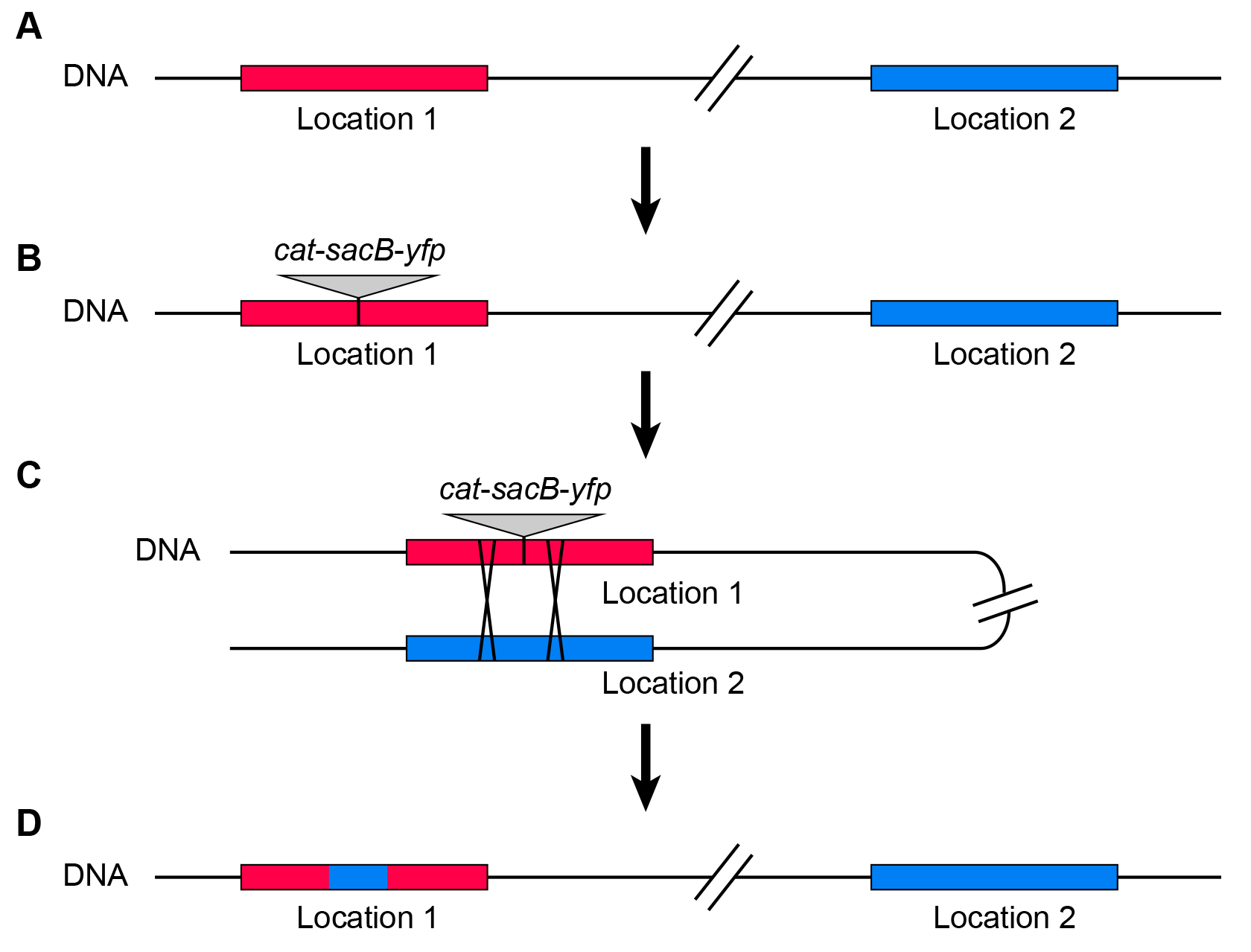
Figure 1. Principle of the assay. A. The assay measures recombination rates between two homologous locations within the chromosome. B. Initially, a selectable/counter-selectable marker is inserted into one of the homologous locations (not part of this protocol). C and D. Spontaneous homologous recombination between the two locations (C) can lead to the removal of the inserted cassette (gene conversion) and the resulting strains (D) can be isolated due to the loss of the counter-selectable marker gene.
Materials and Reagents
- PCR tubes
- 1.5 ml Eppendorf tubes
- 15 ml test tubes
- Plastic Petri dishes (9 cm diameter) for bacterial growth
- Sterile loops (1 µl)
- Pipette tips
- 250 ml E-flask
- 50 ml plastic tubes
- Electroporation cuvettes, 1 mm gap (BTX, product number: 45-0124)
- Salmonella enterica serovar Typhimurium strain LT2 (Biosafety level 2)
- PCR primers that bind outside of the cassette insertion site
- Ampicillin (Sigma-Aldrich, catalog number: A9518)
- Chloramphenicol (Sigma-Aldrich, catalog number: C0378)
- Glucose (Sigma-Aldrich, catalog number: G7021)
- Bacteriological agar (Oxoid, catalog number: LP0011)
- Ethanol (95%)
- PCR Master Mix (2x) (Thermo Fisher, catalog number: K0171)
- Sodium chloride (Sigma-Aldrich, catalog number: S3014)
- Sucrose (Sigma-Aldrich, catalog number: 84100)
- Tryptone (Oxoid, catalog number: LP0042)
- Yeast extract (Oxoid, catalog number: LP0021)
- LB medium (see Recipes)
- LA plates (see Recipes)
- Salt-free LA + 5% sucrose (see Recipes)
Equipment
- Test tube racks
- Autoclave
- Incubator at 37 °C
- PCR machine
- Pipettes (10 µl, 20 µl, 100 µl and 1,000 µl)
- Shaking incubator at 37 °C
- UV Transilluminator (e.g., 365 nm)
- Shaking incubator at 30 °C
- Shaking water bath at 43 °C
- Centrifuge (temperature controlled) for 50 ml tubes (Thermo Scientific, model: Haraeus Megafuge 16R)
- Centrifuge (temperature controlled) for Eppendorf tubes (Eppendorf, model: Centrifuge 5424R)
- Electroporator (Bio-Rad, model: Gene Pulser Xcell)
Procedure
文章信息
版权信息
© 2019 The Authors; exclusive licensee Bio-protocol LLC.
如何引用
Brandis, G., Cao, S. and Hughes, D. (2019). Measuring Homologous Recombination Rates between Chromosomal Locations in Salmonella. Bio-protocol 9(3): e3159. DOI: 10.21769/BioProtoc.3159.
分类
微生物学 > 微生物遗传学 > 重组
分子生物学 > DNA > DNA 重组
您对这篇实验方法有问题吗?
在此处发布您的问题,我们将邀请本文作者来回答。同时,我们会将您的问题发布到Bio-protocol Exchange,以便寻求社区成员的帮助。
提问指南
+ 问题描述
写下详细的问题描述,包括所有有助于他人回答您问题的信息(例如实验过程、条件和相关图像等)。
Share
Bluesky
X
Copy link



